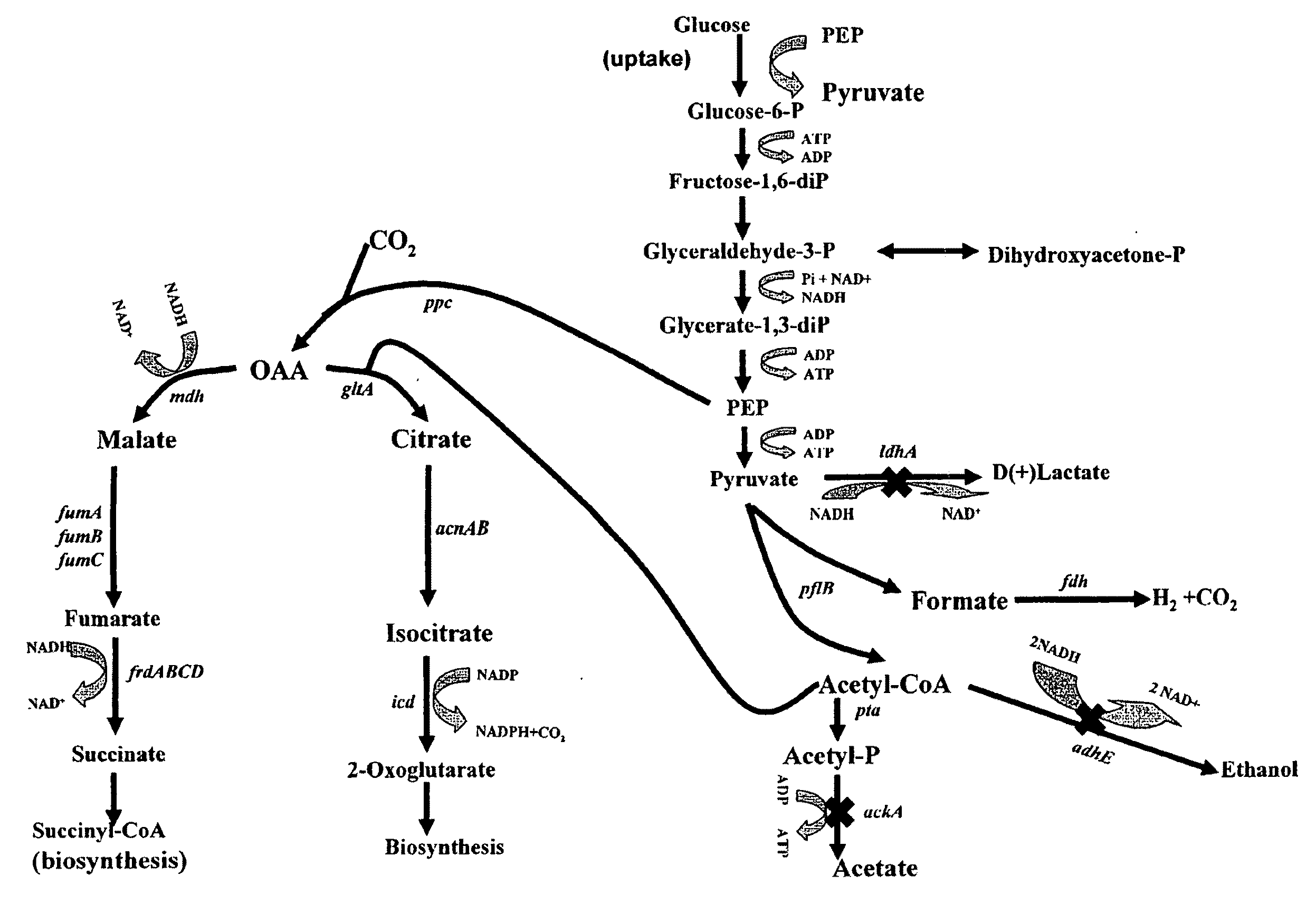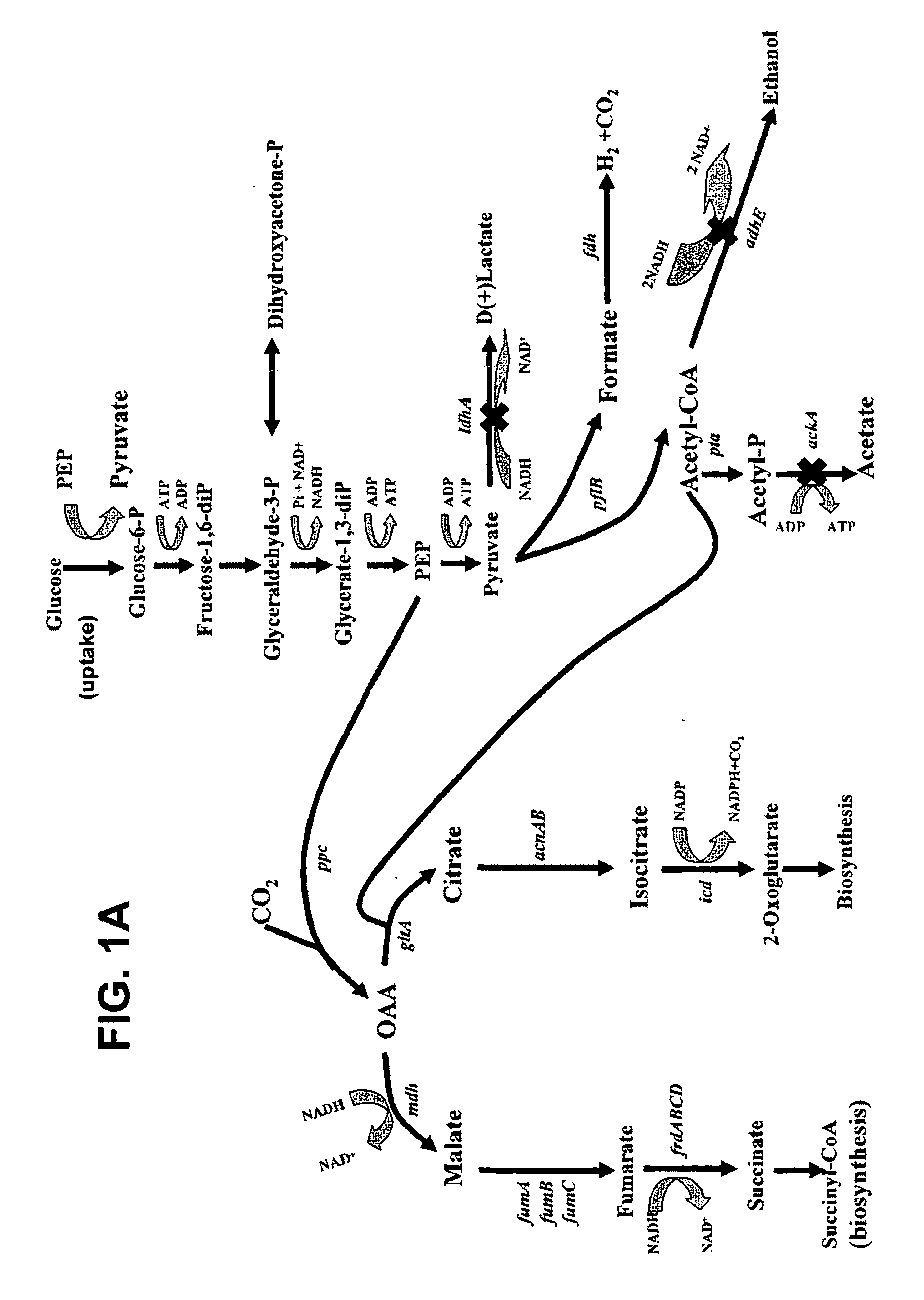Materials and Methods for Efficient Succinate and Malate Production
- Summary
- Abstract
- Description
- Claims
- Application Information
AI Technical Summary
Benefits of technology
Problems solved by technology
Method used
Image
Examples
example 1
[0091]Microorganisms were deposited with the ARS Culture Collection as follows:
CultureStrain DesignationsDeposit DateKJ012B-50022Mar. 15, 2007KJ017B-50023Mar. 15, 2007KJ032B-50024Mar. 15, 2007KJ060B-50025Mar. 15, 2007KJ070B-50026Mar. 15, 2007KJ071B-50027Mar. 15, 2007KJ072B-50028Mar. 15, 2007KJ073B-50029Mar. 15, 2007
Materials and Methods
Strains, Media and Growth Conditions
[0092]Strains used in this study are summarized in Table 2. Derivatives of E. coli C (ATCC 8739) were developed for succinate production by a unique combination of gene deletions and selections for increased productivity. Cultures were grown at 37° C. in modified Luria-Bertani (LB) broth (per liter: 10 g Difco tryptone, 5 g Difco yeast extract, 5 g sodium chloride) (Miller, 1992) only during strain construction. Antibiotics were included as appropriate.
[0093]NBS mineral salts medium (Causey et al., 2004) supplemented with 100 mM KHCO3, 1 mM betaine HCl, and sugar (2% to 10%) was used as a fermentation broth in most ...
example 2
[0136]Microorganisms were deposited with the ARS Culture Collection as follows:
CultureStrain DesignationsDeposit DateKJ073B-50029Mar. 15, 2007KJ091B-50110Feb. 20, 2008KJ098B-50111Feb. 20, 2008KJ104B-50112Feb. 20, 2008KJ110B-50113Feb. 20, 2008KJ119B-50114Feb. 20, 2008KJ122B-50115Feb. 20, 2008KJ134B-50116Feb. 20, 2008
Materials and Methods
Strains, Media and Growth Conditions
[0137]New derivatives of E. coli C (ATCC 8739) were developed for succinate production using a unique combination of gene deletions coupled with growth-based selection. Strains, plasmids, and primers used in this study are summarized in Table 1. During strain construction, cultures were grown at 37° C. in modified Luria-Bertani (LB) broth (per liter: 10 g Difco tryptone, 5 g Difco yeast extract, 5 g sodium chloride) (Miller, 1992) and supplemented with antibiotics as appropriate (Jantama et al., 2008; Zhang et al., 2007). No genes encoding antibiotic resistance, plasmids, or foreign genes are present in the final st...
PUM
| Property | Measurement | Unit |
|---|---|---|
| Fraction | aaaaa | aaaaa |
| Fraction | aaaaa | aaaaa |
| Fraction | aaaaa | aaaaa |
Abstract
Description
Claims
Application Information
 Login to View More
Login to View More - R&D
- Intellectual Property
- Life Sciences
- Materials
- Tech Scout
- Unparalleled Data Quality
- Higher Quality Content
- 60% Fewer Hallucinations
Browse by: Latest US Patents, China's latest patents, Technical Efficacy Thesaurus, Application Domain, Technology Topic, Popular Technical Reports.
© 2025 PatSnap. All rights reserved.Legal|Privacy policy|Modern Slavery Act Transparency Statement|Sitemap|About US| Contact US: help@patsnap.com



